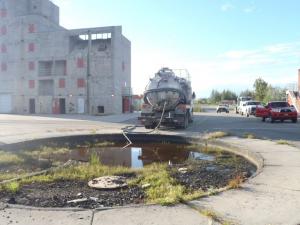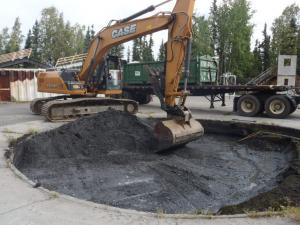Water Contamination Issue
June 2022 Update: EPA Announces New Drinking Water Health Advisories for PFAS Chemicals
On Wednesday, June 15, 2022, the US Environmental Protection Agency (EPA) announced several non-enforceable health advisories for certain Per- and Polyfluoroalkyl Substances (PFAS), including new interim health advisories for Perfluorooctanoic Acid (PFOA) and Perfluorooctane sulfonate (PFOS), as well as final health advisories for GenX and Perfluorobutane sulfonic acid (PFBS). More information on these advisories can be found at Drinking Water Health Advisories (HAs) | US EPA: https://www.epa.gov/sdwa/drinking-water-health-advisories-has
Issue Background and Local Response
Perfluorinated compounds (PFCs), chemicals found in fire-fighting foams manufactured starting in the mid 1980s by 3M and Dupont were first discovered at the City of Fairbanks Regional Fire Training Center (RFTC) in 2015 when the City of Fairbanks sampled standing water contained within the burn pit (see google map of training center on north side of 30thAvenue). In September 2015, Shannon & Wilson, Inc. (S&W) completed an initial investigation of soil and groundwater on the RFTC property and found PFCs and petroleum compounds in the groundwater on the site.
The burn pit is 30 feet in diameter and lined (Figure 2). Firefighting foam containing PFCs used by various local, state, and federal entities during training exercises at the site, is suspected to have leaked through the liner or over-sprayed the edges of the pit during training activities until use ceased in 2004. The burn pit was constructed in 1984.
In August 2017 the City Engineering Department, Alaska Department of Environmental Conservation (ADEC), and S&W developed a scope of work for NRC Alaska, LLC to excavate the pit area. Based on soil test results and recommendations from ADEC Contaminated Sites Program staff, the work plan included removal of standing contaminated water and ~185 cu/yds of soil directly below the surface, in an attempt to remediate the most significant source of PFC and petroleum contaminants at the RFTC property.

After the initial discovery of the contaminants at the source site in 2015, the City and their consultant took immediate action to:
- a) identify and test any domestic or commercial active drinking water wells downgradient of the RFTC, and
- b) provide free delivery of a clean drinking water alternative for those properties with contaminated water samples, and
- c) initiate design & construction effort to provide permanent municipal water to properties where wells tested above LHA levels, and
- d) host three Community Meetings to explain the test results, provide health-related information, and an opportunity for residents to ask questions

Regulatory Health and Cleanup Levels
The U.S. Environmental Protection Agency (EPA) issued a lifetime health advisory (LHA) level of 70 nanograms per liter (ng/L) for the sum of the PFOS and PFOA concentrations in drinking water sources in 2016. This new level is significantly lower than prior advisories resulting in an increased need for more widespread investigation of drinking water. While much is still unknown regarding clear linkages between the accumulation of PFCs in humans and disease, the potential health impacts were enough to cause the City to take a cautious approach when setting levels for determining when to provide affected properties with a new water service. In summer of 2017, the City began providing new, free-of-charge municipal water connections to properties with existing domestic drinking water wells whose sample results tested at, or above, 65 ng/L for combined PFOS/PFOA.
UPDATE: On September 25, 2017, local Ordinance No. 6060 was adopted that lowered the threshold for the provision of new water service at no-cost to those properties with wells that test above 85% of the EPA advisory, or above 59.5 ng/L for PFOA + PFOS.
The Alaska Department of Environmental Conservation (ADEC) published cleanup levels for two types of PFCs, perfluorooctane sulfonate (PFOS) and perfluorooctanoic acid (PFOA), in groundwater in November 2016. The new groundwater-cleanup levels are described at http://dec.alaska.gov/spar/regulation_projects/cs18AAC75.htm. The City is committed to working with ADEC to monitor groundwater in the future.
What are PFCs?
Perfluorinated compounds (PFCs) are “emerging contaminants,” or chemicals with limited data on human health effects. Two compounds, perfluorooctane sulfonate (PFOS) and perfluorooctanoic acid (PFOA) are the most studied. PFCs are used in products that resist fire, stains, grease, and water. While PFCs can be found in firefighting foam, they can also be present in furniture and carpets treated for stain resistance, waterproof clothing, and food packaging. Beginning in 2000, 3M and other major manufacturers of fire-fighting foams and consumer products containing PFC-related chemicals began to phase out the use of PFOS in these products due to findings that these chemicals can be harmful. However, foams with PFOA and similar perfluorinated compounds continue to be manufactured and used for firefighting.
PFCs that enter the environment are known to persist for a long time and may travel long distances in groundwater. They also are known to bioaccumulate in organisms.
In 2016, EPA set a recommended combined level for PFOA + PFOS in drinking water of 70 parts per trillion. 70 parts per trillion are equivalent to about a drop of water in 20 Olympic-sized swimming pools. EPA said that at this level or below, the chemicals are “not expected to result in adverse health effects over a lifetime of exposure.”
To provide Americans, including the most sensitive populations, with a margin of protection from a lifetime of exposure to PFOA and PFOS from drinking water, EPA has established the health advisory levels at 70 parts per trillion.
- What’s a health advisory?
- Health advisories provide information on contaminants that can cause human health effects and are known or anticipated to occur in drinking water. EPA’s health advisories are non-enforceable and non-regulatory and provide technical information to states agencies and other public health officials on health effects, analytical methodologies, and treatment technologies associated with drinking water contamination. EPA’s health advisory level for PFOA and PFOS offers a margin of protection for all Americans throughout their life from adverse health effects resulting from exposure to PFOA and PFOS in drinking water.
Current Investigations and Water Service Connections
Due to concern about PFCs in drinking water, the City of Fairbanks with the help of their consultant has been searching for, and testing, water supply wells (including drinking water wells) for PFCs in groundwater since August 2015 (see Response Timeline). To date, many wells in the search area have been tested two or three times.
The well search was expanded iteratively away from the RFTC in the general direction of groundwater flow (northwest) between February 2016 and 2017, and extended to properties on both sides of the Chena River between Loftus Road and University Avenue. Based on the latest round of results, no properties north of the Chena River were found to have PFC level approaching or over the LHA.
The City of Fairbanks is currently providing no-cost clean water connections to residents with wells that have tested above the EPA’s recommended threshold for PFOA + PFOS, and by October of 2017 had connected 41 affected property owners (44 connections) to the local municipal water system (USA, Inc.). The City has plans to connect additional homes and businesses to municipal water during 2018 construction season. These ‘high priority’ properties are those dependent upon wells for residential drinking water, or have wells and holding tanks, and have PFC contaminant samples exceeding 85% (59.5 ng/L) of EPA’s advisory levels.
The City continues to conduct outreach to affected residents and held two Community “Open House” Informational Meetings in fall 2016 and a third meeting in August 2017 with support from the State of Alaska Department of Health and Social Services, the ADEC, and consultants.
Future Plans
The City of Fairbanks continues to work with property owners, ADEC and S&W to identify additional wells for testing and to install a monitoring well network to help us to better understand both the extent and annual fluctuations of contamination levels in the groundwater. As a result of no positive results from properties north of the Chena River, the City plans to focus future sampling on those wells in the search areas with results between 35-65 ng/L and will continue sampling these on a bi-annual basis.
If you have any questions or need additional information, please contact John O'Brien, Environmental Analyst, City of Fairbanks, Engineering Department, jobrien@fairbanks.us or 907-987-5880.
